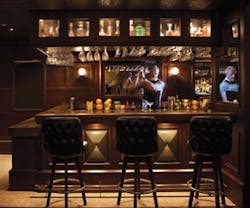As the site of the first ever Academy Awards and a frequent landing pad for the film industry’s most luminous stars, the Hollywood Roosevelt Hotel has long represented that classic sense of elegance that defines the entertainment capital of the world. One of the newest additions to the Roosevelt, the Spare Room, doubles down on that heritage, channeling the sophisticated styles and textures of the city’s old guard into a contemporary destination for patrons looking to escape the crowded nightclub scene.
Tucked into a previously unused portion of the hotel’s mezzanine level, the Spare Room offers patrons the chance to settle into a plush leather loveseat and play a game of chess or backgammon, or roll a few frames on its vintage bowling lanes while overlooking Hollywood Boulevard.
While the space was designed and curated by Studio Collective, a young firm based in Los Angeles, the project’s three principals, Adam Goldstein, Leslie Kale and Christian Schulz, readily acknowledge that the main inspiration and concept for the space came from owners Marc Rose and Med Abrous (who is also director of promotions for Thompson Hotels).
“Marc and Med had a very strong vision for what they wanted to do, which was to create a gaming parlor and a mixology bar, but something that was more unique and more to their own,” says Schulz. “They’re at the age where they’re going out a lot and just being really disenfranchised with the scene in Hollywood, and they wanted to create a place where they could go with their friends, play games, and relax and talk. It was a little more sophisticated.”
“A lot of the imagery they brought to us was turn-of-the-century residences with parlors and game nights, where it was part of hospitality and inviting people over,” adds Goldstein.
With those images in mind, the team from Studio Collective set out to source items that would recreate that sense of time, without feeling historic. Most of the furnishings found in the Spare Room have a residential feel to them, and were sourced at area antique stores. The back bar in the Spare Room is made from an old console built in the classic Hollywood Regency style that was outfitted with a new mirror and interior lighting; the DJ booth is actually a repurposed and reupholstered vanity dating from the 1920s. Difficult-to-find Mastercraft brass cabinets were refurbished and are now used for game storage.
The team commissioned a number of custom pieces for the space as well. In the lower lounge area, game tables featuring dual tops (chess on one side, backgammon on the other) stand next to studded dining tables equipped with small trays that slide out of the side, keeping drinks clear of the gaming action. Low-height, rectangular rosewood tables conceal a number of intricate compartments for storing gaming components, resembling “a James Bond briefcase,” according to Schulz.
“[The rosewood tables] are more of a modern-looking piece,” he says. “They give the space more of a contemporary feel—they rein the space back in, so it doesn’t feel historical. They’re very purposeful and complicated, but a nice surprise when you sit down.”
With the exception of two fixtures behind the main bar, most of the lighting used in the space was also custom built by Santa Anna-based Orion Chandelier to reinforce the Spare Room’s industrial Americana vibe. Hardwood floors in a striking herringbone pattern add texture and help divide the relatively small floorplate into different zones; hexagonal crème mosaic tiles break up the wood pattern.
And while the Spare Room could have easily veered into masculine, “man’s club” territory due to the extensive use of wood and leather, the team was careful to choose furnishings and textures with softer lines and colors to help moderate the design.
“We always knew that [the space] would be lit in an amber way, and it’s very easy to go dark, so we chose jewel tones that show up in the light and that also sort of drive the femininity home,” says Kale. “We did dark golds, and brass was our finish throughout—we also used turquoise, grays, a little bit of velvet, and emerald greens in three different shades.”
Of course, for all of the signature touches put into the space, the true focal point of the Spare Room has to be the two bowling lanes located directly next to the building’s beautifully arched windows. Surrounded by sofas and a plush area rug, the Spare Room’s bowling area manifests itself as an exclusive, ultra-comfortable hangout area for patrons and their closest friends.
Thanks to some dedicated detective work on the parts of Rose and Abrous, who “sourced a guy who warehouses and stores all of the original Brunswick equipment in an old missile silo,” according to Goldstein, the lanes feature real hardwood tongue-and-grove flooring and vintage above-ground equipment—all of which needed to be craned up to the space through one of the windows, due to its sheer weight and size.
A custom-fabricated ball return, based on vintage photos, anchors the bowling approach, while a unique “trophy case” stands at the end of the lanes, featuring custom punch-outs that show strikes, spares and the number of pins knocked down. Old bowling trophies sourced from swap meets and thrift shops fill the case, which also serves to visually and audibly mask the pin setters underneath.
All in all, the Spare Room continues to be a popular draw among Hollywood social circles, providing the opportunity to get out and enjoy a more refined evening with friends. And while the nightlife scene in Hollywood is subject to frequent change, the space’s combination of finely crafted furnishings and carefully curated aesthetics has proven to have an enduring quality.
“[The hotel] wanted something that would stand the test of time,” says Goldstein. “Sixteen months later, I feel like they’re still building momentum and people are still discovering it for the first time, so it’s been very good.”
|
client |
project team Adam Goldstein, principalz lighting flooring photography |
